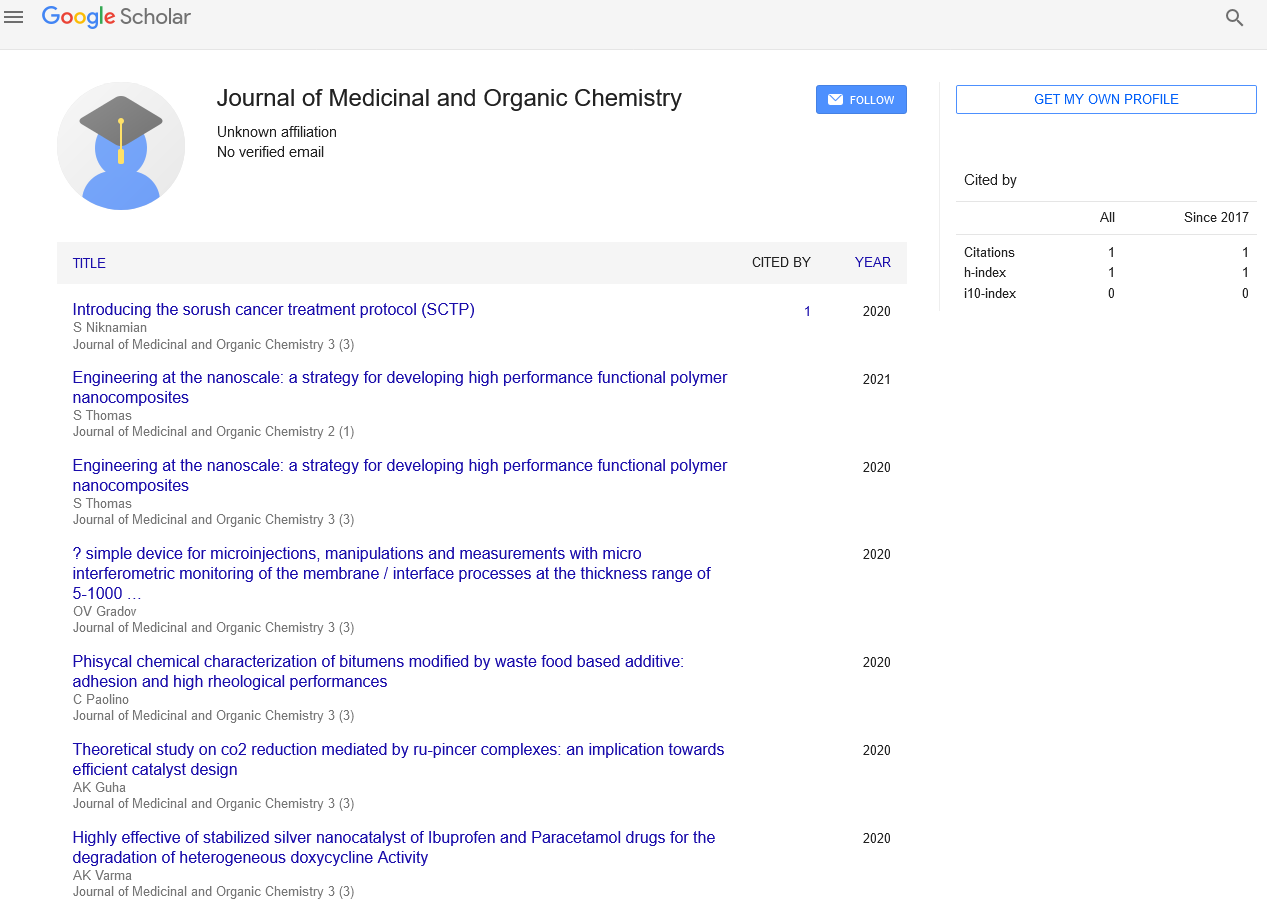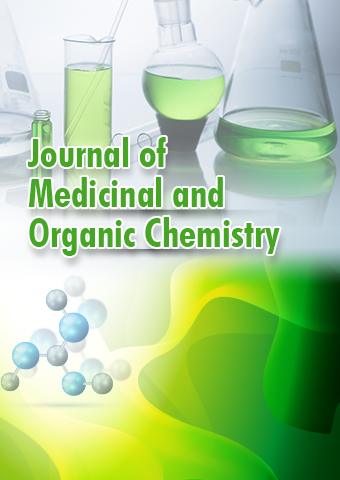Review Article - Journal of Medicinal and Organic Chemistry (2022) Volume 5, Issue 4
PCL Nanoparticles Enhances Anti-Neoplastic Activity of 5-Fluorouracil in Head Cancer
Liliam Takayama*,
Department of Medicine, Renal Division, Hospital das Clinics HCFMUSP, Universidad de Sao Paulo, Sao Paulo
- *Corresponding Author:
- Liliam Takayama*
- Department of Medicine, Renal Division, Hospital das Clinics HCFMUSP, Universidad de Sao Paulo, Sao Paulo
- E-mail:takayama.liliama@univie.ac.at
Received: 02-Aug-2022, Manuscript No. JMOC-22- 72471; Editor assigned: 06-Aug-2022, PreQC No. JMOC-22-72471 (PQ); Reviewed: 20- Aug-2022, QC No. JMOC-22-72471; Revised: 23-Aug-2022, Manuscript No. JMOC-22-72471 (R); Published: 30-Aug-2022; DOI: 10.37532/ jmoc.2022.5(4).60-61
Abstract
Head and neck squamous cell carcinoma (HNSCC), a prevalent cancer worldwide, has a high incidence of loco regional dissemination, frequent recurrence, and lower 5-year survival rates. Current gold standard treatments for advanced HNSCC rely primarily on radiotherapy and chemotherapy but with limited efficacy and significant side effects. In this study, we characterized a novel 5-fluorouracil (5-FU) carrier composed of chitosan solution (CS) and polycaprolactone (PCL) micro particles (MPs) in HNSCC preclinical models. The designed MPs were evaluated for their size, morphology, drug entrapment efficiency (EE %) and in vitro drug release profile. The anti- cancer activity of 5-FU-loaded particles was assessed in HNSCC human cell lines (CAL27 and HSC3) and in a preclinical mouse model (AT84) utilizing cell proliferation and survival, cell motility, and autophagy endpoints. The results demonstrated a 38.57 % in 5-FU entrapment efficiency associated with reduced 5-FU in vitro release up to 96 h post-exposure. Furthermore, CS-decorated PCL MPs were able to promote a significant inhibition of cancer cell proliferation based on the metabolic and colony formation assays, in comparison to controls. In contrast, CS-decorated PCL MPs did not influence the pharmacological efficacy of 5-FU to inhibit in vitro cancer cell migration. Last, cell protein analysis revealed a significant increase of autophagy and cell death evaluated by LC3-II expression and PARP1 cleavage, respectively.
Keywords
Epithelial Malignancy • Nano-formulations • Polycaprolactone
Introduction
Head and neck squamous cell carcinoma (HNSCC) is a prevalent epithelial malignancy of the upper aerodigestive tract (UADT), including the oral cavity, pharynx, larynx, and Para nasal sinuses. This cancer has high rates of loco-regional recurrence, which often occur within the first years [1]. At present, the 5-year survival rate for HNSCC remains below 50 %. The treatment decision is based on clinical and pathological characteristic with surgery and radiotherapy being the main options for respectable forms. For advanced stages, surgery combined with adjuvant radiation or chemo radiation (CRT) are the standard treatment but these approaches often impact on lifelong morbidity associated with treatment side effects and long-term squeals.
Nano-formulations to improve drug delivery have emerged as a promising therapeutic strategy intended to increase the therapeutic index of drugs and to prevent secondary drug side effects by delivering drugs via different mechanisms, such as solubilisation, passive or activeargeting and triggered slow release [2]. In many instances, targeted drug delivery using micro particles (MPs) have revealed advantageous by increasing the therapeutic index of many chemo- therapy drugs and by preventing host toxicity due targeted cell uptake and intracellular trafficking resulting in reduced accumulation in healthy tissues [3].
Description
The interfacial PCL disposition followed by acetone displacement permitted the formation of 100PCL and 100PCL-5FU MPs with agglomeration after lyophilisation process. The irregular surface was observed in both MP with and without 5-FU.The PCL composite sponges mixed with CS in different volume (100CS-0PCL, 75CS-25PCL and 50CS-50PCL) did not show polymer precipitation and resulted in a single-phase homogeneous solution. After lyophilisation, porous morphology of composite sponges was observed under microscopy. SEM analysis of eight samples of CS-PCL MPs (100PCLInternational Journal of Biochemistry and Cell Biology 134 (2021) 105964 4100PCL- 5FU) and SPs (PCL50CS, PCL50CS-5FU, 75CS, 75CS-5FU, 100CS and 100CS-5FU) demonstrated different morphologies. The sponges 75CS and 100CS showed highly porous surface with micro channels network, which could increase the drug loading capability [4]. The PCL addition changed the morphology, and the PCL composite sponges became compact and less porous. The 50CS composite was less porous with dense surface without external particles as the other SPs. These results confirmed previous studies showing that the increased concentration of PCL increases surface homogeneity and density. The 5-FU loading does not change the MP in order to determine whether composite sponges and MPs affects autophagy in HNSCC cells, we investigated formation of autophagosomes in vitro by detecting the conversion of microtubule-associated protein 1 light chain 3 (LC3-I) to lapidated LC3-II, a classical marker of autophagy regulation. The protein analyses showed an increase of LC3- II conversion in cells treatment during 48 h in the samples containing 5-FU and the highest CS concentrations [5]. The LC3 limitation can reflect the induction of a different/modified pathway such as LC3-associated phagocytosis and the no canonical destruction pathway of the paternal mitochondria. The composite sponges and MPs containing 5-FU induced PARP1 expression and LC3 activation in a similar manner as the drug alone, reinforcing that the coating does not interfere with drug activity. Based on our results, the potential molecular mechanisms involved in cell death in HNSCC triggered by our synthetized composite sponges and MPs is probably through the increased autophagy and DNA damage by PARP1 hyperactivity and the lipid LC3-II. The porous surface of our SPs offer significant benefits over others MPs, such as a 3D matrix, to load drugs that can also act as a niche for cell regenerate. We re-engineered a porous platform with 5-FU sustainable for drug release made with natural e-synthetic polymers. This approach was specially designed as a strategy to reduce 5-FU induced HNSCC early relapses and loco-regional recurrence. Further clinical investigation could provide new application of the controlled release of CT agents after HNSCC tumours resection synthetized composite sponges of chitosan solution (CS)-decorated vitro release profiling of 5-FU from the MPs and SPs was measured using lyophilized formulations by the dialysis bag method pre-soaked in phosphatebuffered saline polycaprolactone (PCL) did not interfere with the pharmacological efficacy of the 5-fluorouracil in head and neck cancer cell lines when compared with the controls. The presence of PCL was not related to the drug release rate but rather decreased the material porosity. Thus, our results support the potential clinical utility of CS-decorated PCL MPs as 5-FU-delivery carrier to improve therapeutic efficacy of this major drug in HNSCC.
Acknowledgement
None
Conflict of Interest
None
References
- Adhikari HS, Yadav PN Anticancer activity of chitosan, chitosan derivatives,and their mechanism of action. Int. J. Biomater. 123,132-139 (2018).
- Ahmadi F, Oveisi Z, Samani SM et al. Chitosan based hydrogels: characteristics and pharmaceutical applications. Res Pharm Sci. 10 (1), 1–16 (2015).
- Cadoni G, Giraldi L, Petrelli L et al. Prognostic factors in head and neck cancer: a 10-year retrospective analysis in a single-institution in Italy. Acta Otorhinolaryngol Ital. 37 (6), 458-469 (2017).
- Cameron RE, Kamvari-Moghaddam A. Synthetic Bioresorbable Polymers. 43–66 (2008).
- Dourado MR, Korvala J, Cervigne NK et al. Extracellular vesicles derived from cancer-associated fibroblasts. (2019).
Indexed at, Google Scholar , Crossref
Indexed at, Google Scholar , Crossref
Indexed at, Google Scholar , Crossref

